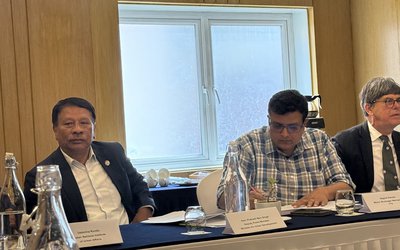
The First Annual Report on the World Humanitarian Summit is out, and here I am presenting my brief observation on where Nepal is in comparison to global progress and gaps.
In May 2016, the World Humanitarian Summit was held to set a forward-looking agenda for humanitarian action to collectively address future humanitarian challenges. The aim was to build a more inclusive and diverse humanitarian system committed to humanitarian principles.
Some of the key areas that the Annual Report has outlined are:
(I) The humanitarian-development divide is being bridged
The report indicates the stakeholders are taking seriously the need to program differently and over multi-year horizons in protracted crisis and are finding ways to overcome institutional divides, while some donors are increasing humanitarian multi-year funding.
Everywhere including Nepal, there has been from the beginning the divide, both emerging at different times and evolving at separate speeds. Following the earthquake in Nepal, there have been initiatives taken by development organizations to bridge the humanitarian and development divide through linking relief, rehabilitation and development (LRRD) approach.
There is a greater awareness that the humanitarian-development divide seems irrelevant in Nepal where people face a combination of poverty, inequality and threats from disasters. However, LRRD needs to be institutionalized as a national approach to address poverty that disasters can generate or intensify, as well as it can reduce disaster risks and improve preparedness that poverty and vulnerability can generate or intensify.
International community should further increase multi-year and flexible funding and accelerate it’s alignment to the achievement of collective outcomes in support to the local governance operation.
(II) The world has committed to new approaches to address displacement
The report indicates that there have been new approaches to support towards short- and long-term needs of refugees and host communities, with renewed focus on education and livelihoods. However, there has been no significant progress to reduce internal displacement.
In Nepal, historical forms of bonded labor persist, as internal displacement, in agriculture and cattle rearing, and forced labor in brick kilns, stone breaking, night entertainment, domestic works, restaurant and embroidered textiles are prevalent.
The local government should strengthen legal framework, and provide transitional support packages for families coming out of bonded labor, with educational opportunities, housing and alternative sources of income to prevent negative coping strategies.
(III) A global effort is underway to support local humanitarian action
The report indicates that good steps have been taken to channel more funding directly to local partners and investing in capacity-building of local organizations. However, national and local actors feel excluded from critical conversations, still expected to fit into international systems rather than leading through new and empowering mechanisms.
In Nepal, the humanitarian response to earthquake disaster strengthened local capacities, and people had access to information and participated in decisions that affect them at varying degree. Based on the experience, the government should strengthen grievance handling and response mechanism at all levels, while I/NGOs should strengthen local organizations in preparedness, response, coordination and resource management.
Overall, Nepal is making a progress on key agendas of World Humanitarian Summit. Nevertheless, we need to do more to reduce vulnerability to natural hazards and address the root causes of poverty. The local government should invest more in resilience keeping people at the center of humanitarian and development action.
- World Humanitarian Day 2024: Committing to Peace and Accountability
- Aug 19, 2024
- Nepal Investment Summit: Unlocking Economic Potentials For Growth And Development
- Apr 28, 2024
- Investing In Women: Accelerating Progress
- Mar 10, 2024
- Embracing The 'Empty Chair: Advancing Global Inclusivity And Equitable Development
- Dec 29, 2023
- Mental Health In Youth
- Jul 16, 2023















